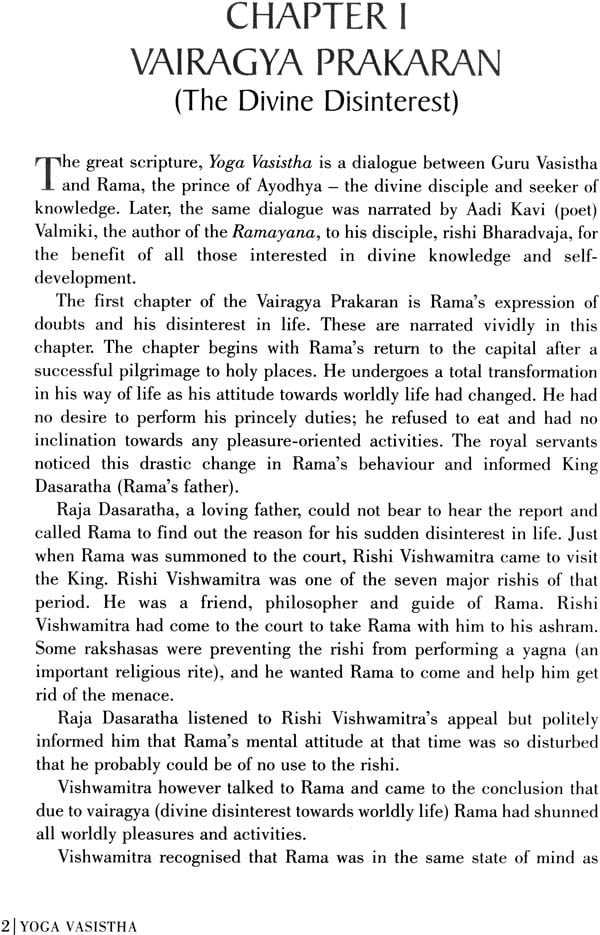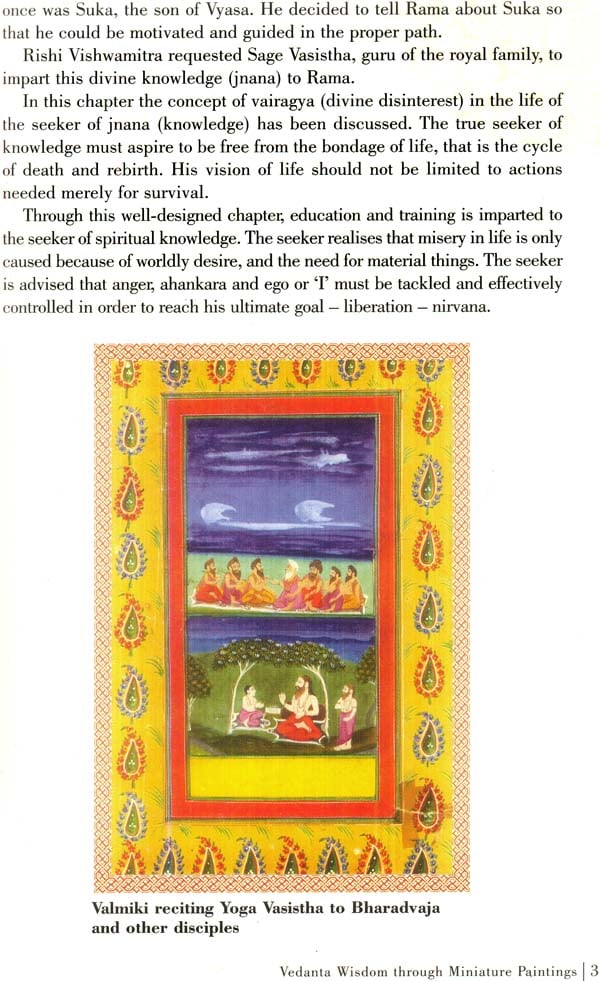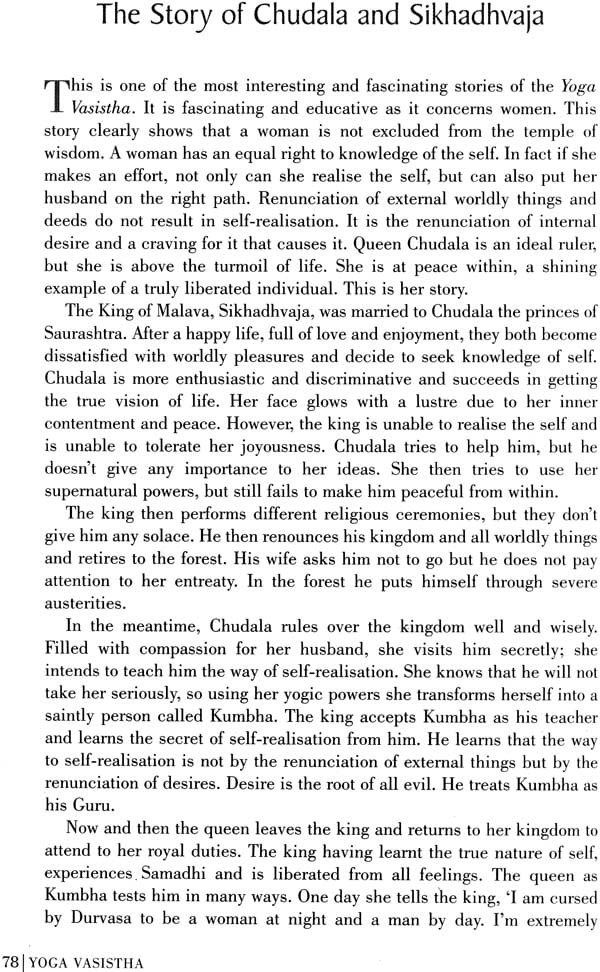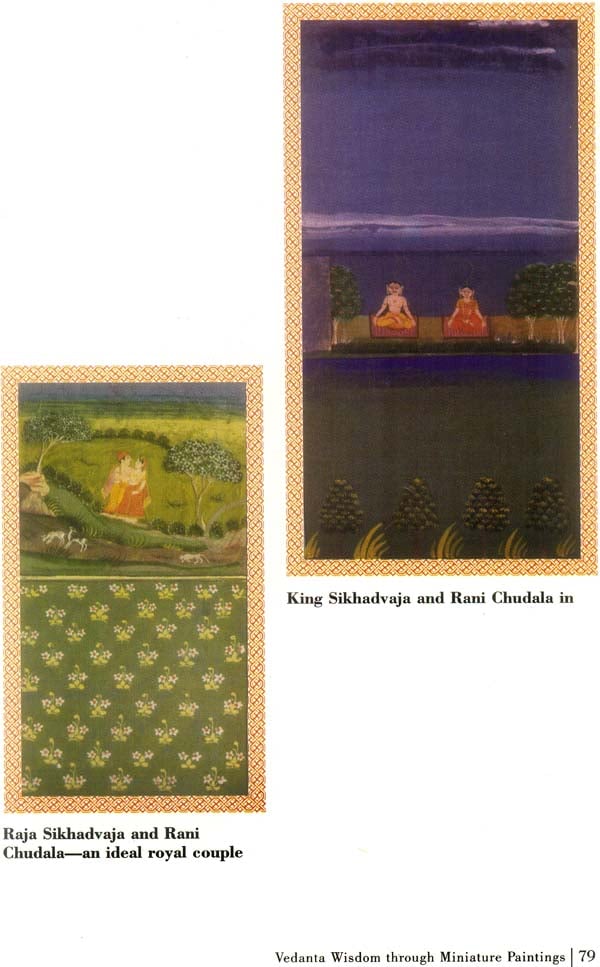
Yoga Vasistha (Vedanta Wisdom Through Miniature Paintings)
Book Specification
| Item Code: | IDK978 |
| Author: | Bhaskar Raj Saxena |
| Publisher: | Rupa Publication Pvt. Ltd. |
| Edition: | 2008 |
| ISBN: | 9788129113191 |
| Pages: | 140 (Illustrated Throughout In Color) |
| Cover: | Paperback |
| Other Details | 8.9" X 6.0" |
| Weight | 350 gm |
Book Description
Foreword
In the words of Dr B L Atray, who did his doctorate on the Philosophy of the Yoga Vasistha, ‘The Yoga Vasistha is a holy Ganges of Advaita Philosophy issuing forth from the Himalayas of the Upanishads, flowing onward to the infinite ocean of the future and increasing in its depth, volume and breadth as it passes on at the Prayaga of Hindu culture, where it is enriched by the quiet Yamuna of Buddhism and the invisible yet present Saraswati of the Samakhya thought, both having their source in different oceans of the Himalayas of the Upanishads. The Yoga Vasistha is the sacred Triveni.’
In a lecture delivered in the USA in 1904, the great saint Swami Rama Tirtha said, ‘One of the greatest books, the most wonderful ever written under the sun, the Yoga Vasistha which nobody on the earth can read without escaping God is consciousness.’
The cause and remedy of sufferings, self effort versus the destiny of the yogi (aspirant) to get freedom from suffering and ignorance, the teachings of Vasistha are intellectual and are meant for those who have acquired basic knowledge and intelligence. According to Swami Rama Tirtha, the remedy for al suffering springs from the mind. Life he says, as lived by the ignorant is full of misery and suffering. There is no lasting happiness as the life lived by the ignorant is full of changes such as death, deception, imperfection and ignorance. A person who wants to be happy, perfect and wise, should have a strong and ripe mind to understand and appreciate knowledge (Bramhagyana). Vasistha used a novel technique of illustrating his teaching through stories has depicted in the entire text.
This book contains miniature paintings depicting the stories of the epic Yoga Vasistha. The description of each story is of the full text of the original. The reader should consult any publication on Yoga Vasistha for full and indepth study of the epic Yoga Vasistha.
Introduction
Yoga Vasistha, the great epic on Vedanta is a dialogue between Rishi Vasistha and Lord Rama which takes place with the consent of King Dasaratha.
Rama returns to Ayodhya after a pilgrimage to different teerthas (sacred places) and is a changed person. He refuses to take on his royal responsibilities and spurns his worldly possessions. Raja Dasaratha is dismayed at the change in Rama. He calls his beloved son and asks, ‘why are you so despondent and indifferent to your duties?’ Rama remains silent. At that moment Vishwamitra comes to Dasaratha’s court. The Raja is delighted to see Vishwamitra and warmly embraces him. Vishwamitra has a favour to ask: ‘Your lordship I request you to allow Rama to accompany me to the ashram. The rakshasas are obstructing the Yagna. I need Rama’s help to overcome the challenge.’ The Raja replies, ‘I would be honoured to accompany you in the place of Rama.’ Vishwamitra is furious with the Raja’s response, as his heart and mind are set that the valiant Rama accompany him.
Rishi Vasistha tries to defuse the situation by asking Raja Dasaratha to concede to Rishi Vishwamitra’s request. Reluctantly Raja Dasaratha commands, ‘Bring Rama to the court.’ A dejected Rama enters the court. Vishwamitra is surprised, ‘Why Rama! Why are you so downhearted?’ Rama replies, ‘My Lord, I have learnt a lot from my travels. Wealth is divided unequally. While we live in luxury, many in our kingdom don’t even get a square meal. Our luxury has led us to greater desires for material things. Our power has made us feel that we are invincible and that we can rule the minds and in fact souls of the people. I prefer starvation to death!’
Vishwamitra saw the truth in what Rama said. He requested Rishi Vasistha, ‘Our Rama has nearly attained self-realisation like Suka, the son of Vyasa. I implore you to teach Rama the gyaan, through stories to help him in his quest.’
The teachings of Rishi Vasistha is in short, the Yoga Vasistha. His teachings consist of six chapters:
Vairagya Prakaran – Detachment (dispassion)
Mumukshu Prakaran – Desire for attainment of Moksha
Utpathi Prakaran – Origin of cosmos
Stithi Prakaran – Existence
Upsham Prakaran – Quiescence
Nirvana Prakaran – Annihilation of the individual ego (liberation)
Vasistha says, ‘Brahman, being perfect has neither a beginning nor an end. He is the cause of the entire universe.’ When Bramhan is associated with nescience it is known as jiva (individual self). The jiva is really pure intelligence and is free of nescience (ignorance).
Truth cannot be known without thinking. Thinking alone leads to the attainment of peace, liberation – ‘Nirvana’. Thinking consists of logical investigation of problems such as who am I, what am I?
Yoga Vasistha illustrates that the soul is self-luminous, everlasting, and omnipresent. The next element described in detail is the mind. The mind is deceptive and egoistic with too much pride and vanity.
The third element is the corporal body formed of five physical elements or prakrati. The concept of sensation and mind has also been defined as the union of the breath of life with the body organs. If this union is merged with desire, the origin of the mind takes place.
This is why the living and sensitive plants are devoid of a mind. Therefore, it is illustrated that the end of desire is the end of the mind and leads to the end of the birth and death cycle, that is Nirvana or emancipation.
Back of the Book
Not many are aware of the fact that the blockbuster Hollywood movie Matrix is based on stories from the Yoga Vasistha and that the New York University has printed a commentary on Yoga Vasistha. Yoga Vasistha-Vedanta Wisdom through Miniature Paintings is an introduction to this unique subject-an epic that provides insights into the ancient Vedanta wisdom, the nature of existence, reality and governance. It contains the timeless wisdom about self and Brahman, the creator, through a series of ancient paintings depicting stories from Yoga Vasistha. According to Vedanta, all one has to do to attain happiness is guide, supervise and control the vagaries of the mind with a strong and alert intellect. Through this intellectual mastery which bestows upon man a power that far exceeds any external empowerment, one can acquire, possess, and enjoy anything the world has to offer.
In this book, the powerful philosophy is depicted in story form through the beauty of miniature paintings, making it even more exquisite and poignant. A treasure which carries a wealth of information about consciousness, the book is a collector’s item-a great compilation of art and philosophy presented aesthetically.
Dr Bhaskar Raj Saxena has worked with multinational pharmaceutical companies for two decades. After retirement he was a visiting faculty to the Government Post Graduate College for Women at Hyderabad and Bharatiya Vidya Bhawan, Hyderabad. He as contributed more than sixty articles in English, Hindi and Urdu in various scientific journals and newspapers and authored two books in Urdu, both of which received awards from the Andhra Pradesh Urdu Academy. He has also edited three books in Hindi including one on Yoga Vasistha. Currently he gives talks on All India Radio, Hyderabad on scientific and cultural topics.
| Introduction | xii |
| CHAPTER - I | |
| Vairagya Prakaran (The Divine Disinterest) | 2 |
| The Story of Recensions | 4 |
| CHAPTER - II | |
| Mumukshu Prakaran (The Divine Seeker) | 6 |
| The Story of Suka | 8 |
| The Story of Vasistha | 10 |
| CHAPTER - III | |
| Utpatti Prakaran (The Origin) | 12 |
| The Story of Akasaja | 14 |
| The Story of Lila | 16 |
| The Story of Karkati | 22 |
| The Story of the Sons of Indu | 24 |
| The Story of Indra and Ahalya | 26 |
| The Story of Lavana | 28 |
| CHAPTER - IV | |
| Stithi Prakaran (The Sustenance) | 32 |
| The Story of Sukracharya | 34 |
| The Story of Dama. Vyala and Kata | 36 |
| The Story of Bhima, Bhasa and Drdha | 40 |
| The Story of Dasura | 42 |
| The Story of Kaha | 44 |
| CHAPTER - V | |
| Upasama Prakaran (The Quiescence) | 46 |
| The Story of King Janaka | 50 |
| The Story of Punya and Pavana | 52 |
| The Story of Bali | 54 |
| The Story of Prahlada | 56 |
| The Story of Gadi | 58 |
| The Story of Uddalaka | 60 |
| The Story of Suraghu | 62 |
| The Dialogue between Bhasa and Vilasa | 64 |
| The Story of Vitahavya | 66 |
| CHAPTER - VI | |
| Nirvana Prakaran (The Final Liberation) | 68 |
| The Story of Kag-Bhusunda | 70 |
| The Story of Deva Puja (Worship of God) | 72 |
| The Story of Arjuna | 74 |
| The Story of Bhagiratha | 76 |
| The Story of Chudala and Sikhadhvaja | 78 |
| The Story of Kaca | 88 |
| The Story of Bhiringhisa | 90 |
| The Story of Iksvaku | 92 |
| The Story of a Hunter and a Sage | 94 |
| The Story of Vidya-Dhara | 96 |
| The Story of Manki | 98 |
| The Story of the Mind | 100 |
| The Story of Vipascit | 102 |
| The Story of Sata-Rudra | 106 |
| The Story of Indra | 108 |
| The Story of a Block of Stone | 110 |
| CONCLUSION | 112 |
| INDEX OF PAINTINGS | 114 |









